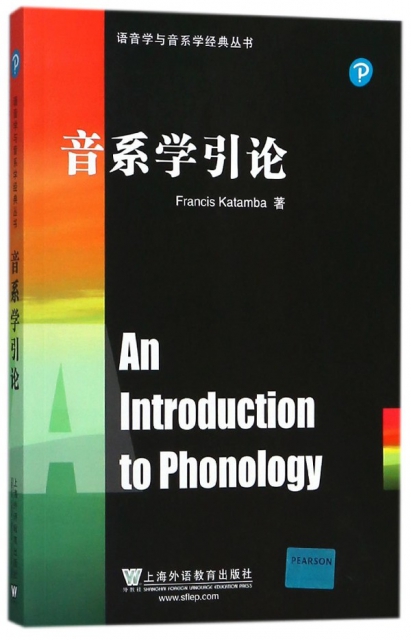| | | | 音繫學引論(英文版)/語音學與音繫學經典叢書 | | 該商品所屬分類:藝術 -> 音樂 | | 【市場價】 | 603-875元 | | 【優惠價】 | 377-547元 | | 【介質】 | book | | 【ISBN】 | 9787544650458 | | 【折扣說明】 | 一次購物滿999元台幣免運費+贈品
一次購物滿2000元台幣95折+免運費+贈品
一次購物滿3000元台幣92折+免運費+贈品
一次購物滿4000元台幣88折+免運費+贈品
| | 【本期贈品】 | ①優質無紡布環保袋,做工棒!②品牌簽字筆 ③品牌手帕紙巾
|
|
| 版本 | 正版全新電子版PDF檔 | | 您已选择: | 正版全新 | 溫馨提示:如果有多種選項,請先選擇再點擊加入購物車。*. 電子圖書價格是0.69折,例如了得網價格是100元,電子書pdf的價格則是69元。
*. 購買電子書不支持貨到付款,購買時選擇atm或者超商、PayPal付款。付款後1-24小時內通過郵件傳輸給您。
*. 如果收到的電子書不滿意,可以聯絡我們退款。謝謝。 | | | |
| | 內容介紹 | |

-
出版社:上海外教
-
ISBN:9787544650458
-
作者:弗朗西斯·卡塔坶巴
-
頁數:328
-
出版日期:2018-04-01
-
印刷日期:2018-04-01
-
包裝:平裝
-
開本:16開
-
版次:1
-
印次:1
-
字數:437千字
-
弗朗西斯·卡塔坶巴著的《音繫學引論》介紹:
This is an up-to-date introduction to
phonological theory placed within the
framework of current, mainstream generative
phonology. The book is divided into two
parts. The first introduces readers to basic
concepts of articulatory phonetics,classical
phonemics and standard generative
phonology;the topics covered include
distinctiveness, naturalness,abstractness
and rule interaction.
The second part is devoted to current
issues in phonological theory; both the
nature and organisation of phonological
representations in nonlinear generative
phonology are explored. It discusses such
areas as the role of the syllable in
nonlinear generative phonology, metrical
phonology and the study of stress,
autosegmental approaches to tone, the place
of intonation, lexical phonology and
morphology, and the syntax-phonology
interface viewed in terms of the domain of
phonological rules.
With analytical exercises in each
chapter and data taken from a wide range of
languages, this book aims not so much to
emphasise the history of phonological
theory, but to develop the reader's
understanding of contemporary phonological
theory through a practical and accessible
approach.
-
Preface
Acknowledgements
Chapter 1 Introduction to phonetics
1.1 Introduction
1.2 The production of speech
1.2.1 The production of consonants
1.3 The production of vowels
Chapter 2 The phoneme
2.1 Segments of sound
2.1.1 Distinctiveness: phonemes and allophones
2.2 Identifying phonemes
2.2.1 The minimal pair test
2.2.2 Contrast in analogous environments
2.2.3 Suspicious pairs
2.2.4 Recapitulation
2.3 Phonological symmetry
Chapter 3 Distinctive features
3.1 Why are features needed?
3.2 Jakobsonian features
3.3 The SPE system of distinctive features
3.3.z Major class features
3.3.2 Cavity features
3.3.3 Tongue body features
3.3.4 Tongue root features
3.3.5 Laryngeal features
3.3.6 Manner features
3.3.7 Prosodic features
3.4 Segment structure redundancy
Chapter 4 Phonological representations
4.1 Phonetics and phonology
4.2 The domain of phonology
4.3 Recapitulation: levels of representation
4.4 Phonetic and phonemic transcription
4.5 A guide to phonetic transcription
4.6 Why study phonology?
Chapter 5 Phonological processes
5.1 Introduction
5.2 Assimilation
5.2.i Direction of assimilation
5.3 Assimilation processes
5.3.1 Palatalisation
5.3.2 Labialisation
5.3.3 Voice assimilation
5.3.4 Place of articulation assimilation
5.3.5 Manner of articulation assimilation
5.3.6 Nasalisation
5.4 Dissimilation
5.5 Conclusion
Chapter 6 Naturalness and strength
6.1 Introduction
6.2 Natural segments, natural classes and natural
processes 98
6.2.1 Phonological strength hierarchies
6.3 Explanations of naturalness
6.3.1 Natural phonology
Chapter 7 Interaction between rules
7.1 Introduction to rule formalisation and ordering
7.2 Linear rule ordering
7.3 Abandoning extrinsic ordering
7.4 Conclusion: why ordering matters
Chapter 8 The abstractness of underlying
representations
8.i Abstractness
8.2 Concrete phonology?
8.3 Absolute neutralisation
8.4 Conclusion
Chapter 9 The syllable
9.1 The syllable
9.2 The representation of syllable structure
9.3 The CV-tier
9.3.1 A generative CV.phonology model of
syllable structure
9.3.2 Syllabification
9.4 Functions of the syllable
9.4.1 The syllable as the basic phonotactic
unit
9.4.2 The syllable as the domain of phonological
rules
9.4.3 The syllable and the structure of complex
segments
9.4.4 Compensatory lengthening
9.4.5 The syllable as indispensable building block
for higher phonological domains
9.5 Syllable weight
9.6 Abstract segments
9.7 Extrasyllabicity
9.8 Summary
Chapter 10 Multi.tiered phonology
10.1 Introduction to tone languages
10.2 The nature of phonological
representations
10.3 The representation of tone
10.3.I Contour tones
10.3.2 Tone stability
10.3.3 Melody levels
10.4 The autosegmental model and the representation of tone
10.5 Tone and intonation
10.6 Pitch.accent
10.7 Vowel harmony
10.8 Nasalisation
10.9 Morphemic tier
Chapter 11 Stress and intonation
11.1 Introduction: stress
11.1.1 What is stress?
11.1.2 Metrical phonology
11.1.3 Metrical trees and grids
11.1.4 Extrametricality
11.1.5 Quantity sensitivity
11..6 English stress
11.2 Intonation
11.2.1 The form of English intonation
11.2.2 Accentuation function
11.2.3 Intonation and illocutionary force
11.2.4 The grammatical function of intonation
11.2.5 Attitudinal functions
11.2.6 Discourse function
Chapter 12 Phonology in the wider context
12.1 The role of the lexicon
12.2 Lexical phonology
12.2.1 Level 1 of lexical phonology
12.2.2 Level 2 of lexical phonology
12.2.3 The elsewhere condition
12.2.4 The order of affixes
12.2.5 Post.lexical rules
12.2.6 Summary
12.3 Prosodic domains
12.3.1 Prosodic domains and French liaison
12.4 Conclusion
Bibliography
Suggested answers to exercises
Language index
Subject index
| | |
| | | | |
|




